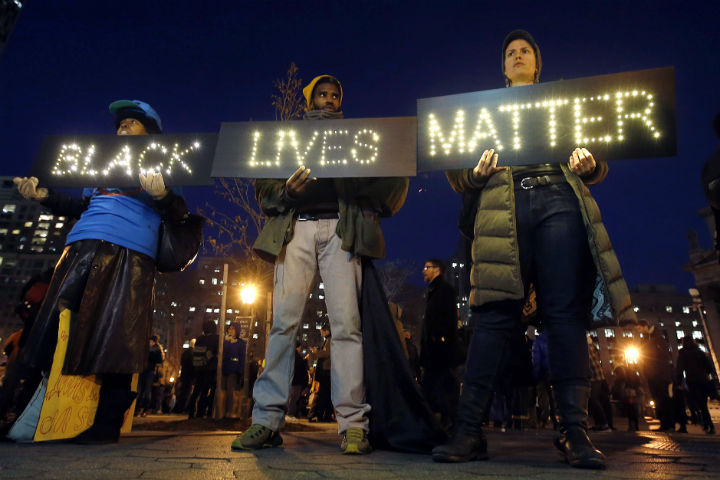“Black Lives Matter advocates dignity, justice and freedom. Not murder.”

Those were the 10 words tweeted out by the leaders of a growing social movement in the United States early Friday after its demonstration in Dallas, Texas ended in a hail of bullets.
Black Lives Matter supporters, who had taken to the streets to peacefully protest the most recent deaths of two African American men, Alton Sterling and Philando Castile at the hands of police, scattered in terror as several suspects apparently opened fire on police simultaneously from an “elevated position.”
At least two civilians were hurt in the cross-fire. Five officers died, and seven others were wounded.
Almost immediately, hateful comments targeting Black Lives Matter (BLM) began appearing online, with people blaming the national movement for what appears, at least as of Friday morning, to have been the actions of four men.
At least one suspect, identified by media as Micah Xavier Johnson, told police he was not affiliated with any group.
It isn’t the first time BLM has been hit with major backlash. Here’s a look at how the movement started, the push-back it has faced, and how it has grown.
A hashtag is born
Black Lives Matter started with a single Facebook post back in the summer of 2013. Activist Alicia Garza, sitting in a California bar, posted a message on the site on the night that neighbourhood watch volunteer George Zimmerman was acquitted of murdering Trayvon Martin, an unarmed 17-year-old African American.
“Black people. I love you. I love us. Our lives matter,” she wrote.
Patrisse Cullors, a community organizer from Los Angeles and friend of Garza’s, saw the post and quickly added a hashtag: #BlackLivesMatter.
READ MORE: What we know about the 5 police officers killed in Dallas
Within days, it had spread like wildfire on social media and become a rallying cry.
Within months, it had migrated off the Internet.
In-person protests and sit-ins began to occur under the Black Lives Matter banner, and in the summer of 2014, the movement was strong enough to attract more than 500 protesters to Ferguson, Missouri, where 18-year-old Michael Brown had been shot dead by police.
Since then, BLM protesters have strategically shut down Chicago’s Magnificent Mile, Washington’s i-395 highway, busy malls and most recently, Toronto’s Pride parade.
Organizers have pushed public officials out of office, prompted uprisings on college campuses across the United States, and met with presumptive Democratic presidential nominee Hillary Clinton.
The movement was third runner-up in 2015 for Time Magazine’s person of the year.
There are now more than 30 official BLM chapters, including the one in Toronto, each responsible for their own activist endeavors, but loosely organized under the same umbrella.
It’s not just about cops
According to its main website, one of the major misconceptions about the Black Lives Matter movement is that it’s all about racial profiling and police violence against African Americans.
“Although it is true that much of the protesting to date has been centered on the issue of police brutality, there is a range of issues that movement work will likely push in years to come,” the website states.
These issues, according to the movement’s leaders, include challenges faced by America’s public education system, a dysfunctional prison system, problems with safe and affordable housing, issues with food security, and reproductive justice for women.
Backlash
One of the chief criticisms of the BLM movement since its inception, and indeed of the hashtag itself, is that to trumpet “Black Lives Matter” implies that non-black lives don’t.
A variety of counter-hashtags and slogans have sprung up since 2013, including #BlueLivesMatter (referring to the lives of police officers), #AllLivesMatter and #WhiteLivesMatter – the latter being a particular favourite of white supremacist groups.
READ MORE: ‘Watch out black lives matter punks,’ ex-congressman tweets after Dallas shooting
BLM’s founders directly address this issue on their website, writing that the statement ‘black lives matter’ is not meant to be anti-white.
“Contained within the statement is an unspoken but implied ‘too,’ as in ‘black lives matter, too,’ which suggests that the statement is one of inclusion rather than exclusion.”
WATCH: Black mom delivers rant against Black Lives Matter movement that goes viral
In spite of efforts to clarify and explain its position, BLM supporters remain subject to online hate, death threats and public criticism from officials (including New Jersey Governor Chris Christie) who believe they are stoking the fires of racial unrest and putting the lives of police at risk.
The movement vehemently denies this.
- Four injured after military horses break loose, stampede in London, U.K.
- Canada refused to repatriate woman from ISIS camp because she can’t be arrested: internal memo
- Russia vetoes UN resolution to prevent nuclear arms race in space
- Why U.S. colleges are turning to police to quell pro-Palestinian student protests















Comments